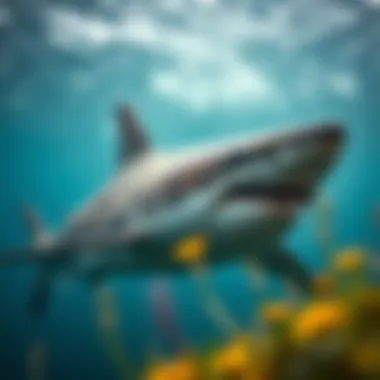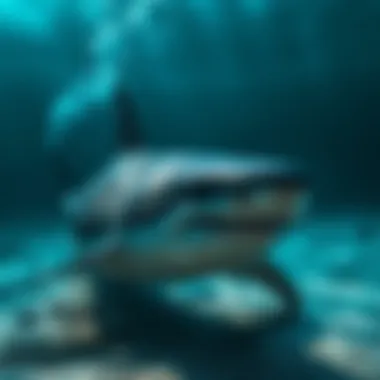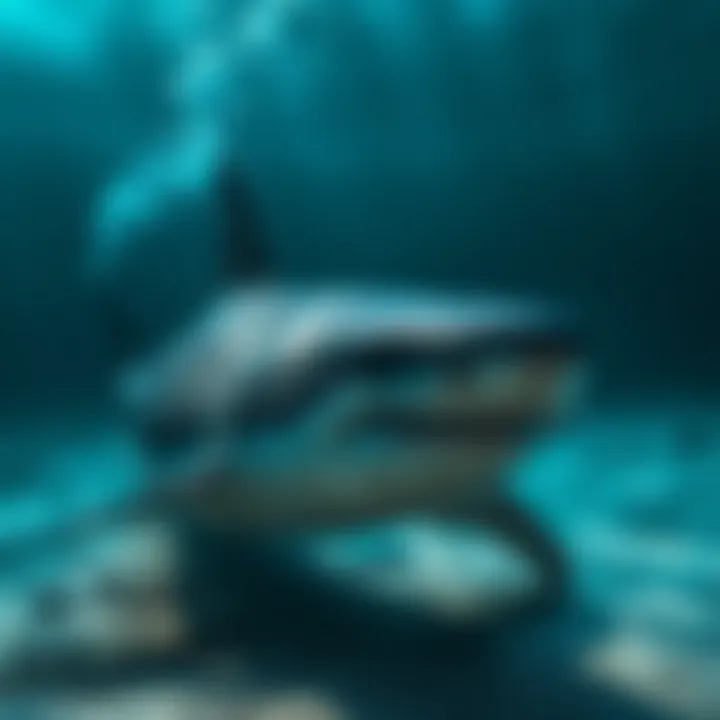A Comprehensive Exploration of Sharks and Their Ecosystem


Intro
Innovation and understanding have led to significant strides in conservation efforts. Yet, myths and misconceptions about sharks linger, deterring many from appreciating their importance. By diving into their evolutionary history and ecological roles, we'll uncover the truth behind these remarkable creatures.
Understanding Sharks
Sharks belong to the class Chondrichthyes, which includes rays and skates. Their distinct features, such as cartilaginous skeletons and exceptional sensory systems, set them apart from bony fish. This section aims to clarify several intriguing aspects regarding their biology and ecology.
Evolutionary History
Having roamed the earth for over 400 million years, sharks have experienced significant evolutionary changes. Their ancestors thrived in a variety of environments long before dinosaurs walked the earth. This long lineage paints a picture of adaptability and resilience, traits vital to their survival in today’s rapidly changing oceans.
Diversity of Species
The shark family is vast, encompassing over 500 species, each uniquely adapted to its environment. Ranging from the gentle whale shark, the largest fish alive, to the fearsome great white, these species demonstrate remarkable diversity. Understanding each species' behavior and ecological role leads to a deeper appreciation of their existence.
"Sharks are not mindless killers; they play an essential role in maintaining the balance of marine ecosystems."
Interaction with Humans
Sharks’ encounters with humans are often shrouded in fear and misunderstanding. While incidents do occur, they are exceedingly rare compared to other dangers found in the ocean or on land. This prompts a need for education on proper shark behavior, aiming to foster respect rather than fear.
Conservation Efforts
Numerous organizations focus on conserving shark populations and habitats, addressing challenges such as overfishing, habitat loss, and climate change. Every action counts, whether it’s advocating for sustainable fishing practices or supporting marine protected areas. Individuals and communities can make strides toward a brighter future for sharks.
Myths and Misconceptions
Debunking common myths surrounding sharks is essential for fostering understanding. For instance, the myth that all sharks are dangerous does not hold up against the facts. In reality, most species are harmless to humans. Addressing these myths can change public perception, encouraging conservation rather than fear.
As we journey deeper into this exploration, we aim to unravel the complexities of sharks and highlight their significance in our world. Together, we can cultivate a greater awareness and promote conservation efforts to ensure their survival for generations to come.
Preface to Sharks
Sharks embody a captivating blend of awe and mystery within the ocean's depths. From the tiny dwarf lanternshark to the colossal whale shark, these creatures are not merely subjects of fascination but also vital players in marine ecosystems. The importance of discussing sharks goes beyond their dramatic appearances and mythos that has taken root in popular culture. As apex predators, they help maintain the balance of marine life, ensuring various species can thrive in their habitats. Understanding sharks enables not just better conservation efforts but also a richer appreciation for the intricate tapestry of oceanic life.
The Significance of Sharks
Sharks have been swimming the seas for over 400 million years, evolving alongside various ecological changes. Their role cannot be overstated—they often sit atop the food chain, guiding the population control of other marine organisms. This has a cascading effect on marine biodiversity, influencing the health and dynamics of ecosystems. When shark populations dwindle, an imbalance occurs; for instance, the overpopulation of prey species can undermine fishery stocks and affect coral reefs.
Furthermore, they contribute to the thriving health of marine communities. By preying on the sick and weak, sharks promote the genetic health of fish stocks. This natural selection process ensures that only the fittest survive, fostering resilience among marine species. Recognizing the essential role of sharks is critical for sustainable management of fisheries and marine environments, as it helps us identify the consequences of overfishing and habitat destruction. In summary, sharks are indispensable for our oceans, and their protection is vital not just for marine biodiversity, but for humans too.
Overview of the Article Structure
This article unfolds in a structured manner, designed to take readers through an in-depth exploration of sharks. It starts from the foundational knowledge of what makes sharks unique, their anatomy and physiology, as well as their evolutionary history. This will offer insights into how sharks have adapted over time and the diversity of species present today.
Following that, we will delve into the behavioral patterns and social structures of sharks, emphasizing their hunting strategies and social interactions. Understanding these behaviors illuminates how sharks communicate within their environment and with each other.
Moreover, the article highlights sharks' roles within ecosystems, detailing their impact as top predators and their relationship with marine biodiversity. The complexities of human-shark interactions will also be addressed, examining public perceptions, media portrayals, and the pressing conservation challenges they face.
In the latter sections, attention will turn towards the future of sharks in light of climate change and ongoing research efforts. Ultimately, the conclusion will synthesize key takeaways and reinforce the importance of safeguarding these fascinating creatures, encouraging readers to advocate for their preservation.
"Understanding sharks is not just about knowledge; it’s about nurturing an appreciation for the essential roles they play in our world."
As we move forward in this exploration, it is crucial to approach the discussion with an open mind and a willingness to learn. The journey through the world of sharks is filled with discoveries that will deepen our understanding of these incredible apex predators.
Anatomy and Physiology of Sharks
The anatomy and physiology of sharks play a crucial role in understanding their remarkable adaptations and behaviors. Their unique body designs and systems have evolved over millions of years, making them exceptionally adept at surviving in various marine environments. By studying these physical traits, one gains insight into not just the shark itself but also the ecosystems they inhabit and the evolutionary pressures that shape their existence.
Unique Physical Characteristics
Skin and Denticles
Shark skin is a fascinating aspect of their anatomy, primarily composed of tiny, tooth-like structures called dermal denticles. These denticles provide a smooth and hydrodynamic surface which reduces drag as they glide through the water. This feature enables sharks to swim more efficiently, making them agile hunters in their aquatic realm. Moreover, the rough surface of shark skin also serves as a protective layer against parasites and injuries, a unique adaptation that speaks volumes about their evolutionary history.


In addition to efficiency, the texture of shark skin can help in social and predatory interactions. Some sharks, like the great white, can appear more intimidating with their rugged skin, which may give them an advantage when foraging or during encounters with other marine animals. This remarkable characteristic not only enhances their survival but also makes them an intriguing subject in the study of marine biology.
Lineage of Sharks
The lineage of sharks traces back to a time before dinosaurs walked the earth. This ancient lineage informs us about the evolution of these predators through the fossil record. Sharks have remained relatively unchanged for around 400 million years, a period during which they adapted various physical traits that have allowed them to thrive in diverse environmental conditions. Their skeletal structure, made primarily of cartilage instead of bone, is an outstanding feature that contributes to their flexibility and buoyancy in water.
The study of shark lineage reveals much about their evolutionary adaptations. For instance, their ability to survive in deep-sea environments starkly contrasts with species that inhabit shallow waters. This remarkable adaptability shows how these creatures have evolved different mechanisms while still retaining certain core characteristics. By understanding their lineage, researchers gain valuable insights into the interconnectedness of marine life and the adaptive successes that have allowed sharks to become apex predators.
Sensory Systems
Sharks are well-known for their acute sensory systems, which give them an edge in hunting and navigating their environments. These systems are not merely for show; they represent a finely tuned array of abilities that ensure their survival in a complex and often competitive ecosystem.
Electroreception
One of the most impressive features of shark physiology is their electroreception capability. Sharks possess specialized organs called ampullae of Lorenzini, which detect electric fields generated by other living beings. This adaptation is particularly advantageous in murky waters or in cases where visibility is low, allowing sharks to locate prey even when it is hidden beneath the sand or cloaked in darkness.
Electroreception also plays a vital role in social interactions. Sharks can use these abilities to navigate and communicate with one another, enhancing their social dynamics and mating behavior. The unique feature of electroreception strengthens their predatory skill set, allowing them to excel in their role as marine hunters.
Smell and Hearing
Perhaps one of the most celebrated aspects of a shark's sensory systems is its sense of smell. Sharks can detect tiny amounts of blood in water from miles away, making their olfactory system extraordinarily powerful. This ability ensures that they can track down potential food sources with remarkable precision.
Hearing also complements their keen sense of smell. Sharks can perceive low-frequency sounds that signal distress or the presence of prey. This sensory combination creates a comprehensive toolkit for hunting, allowing sharks to engage in complex feeding strategies.
In essence, the physical structures that make up the anatomy and physiology of sharks are not only functional but integral to their success as predators. Through understanding these systems, we come one step closer to appreciating the complex roles sharks play in their ecosystems.
"The study of sharks is a gateway to understanding the marine environment as a whole, illustrating the delicate balance of life beneath the waves."
For more information on sharks and their fascinating biology, visit Britannica or check resources from the National Oceanic and Atmospheric Administration.
Evolutionary History of Sharks
Sharks have roamed the oceans for over 400 million years, making their evolutionary history a pivotal component of understanding these creatures. The exploration of their past reveals not only their resilience but also the intricate adaptations that have enabled them to survive and thrive in diverse marine environments. As we delve deeper into their evolutionary lineage, we can draw connections to their current biological form and behavioral patterns, highlighting the significant evolutionary success they have exhibited over millennia. Understanding this history sheds light on the critical roles sharks play in marine ecosystems today, and it can inform conservation efforts aimed at protecting these essential species.
Ancient Lineages
Fossil Evidence
Fossil evidence acts as a tangible link to the past, offering insights into the biological characteristics and habitats of ancient shark species. Notable discoveries like the Cladoselache, a species dating back to the Devonian period, illustrate the primitive features of early sharks. These fossils provide a key characteristic that emphasizes the vitality of sharks' adaptations over time.
One unique feature of these fossils is their teeth, often the only remains found because of their hardy structure. Teeth can reveal a lot about a shark’s diet—an essential aspect in understanding their evolution. For instance, the Serratolamna, which thrived in shallow waters, showcases how dietary needs influenced its evolutionary trajectory. Fossil evidence is generally regarded as a beneficial choice for this topic because it supports the argument of how physical forms and species traits emerged as sharks adapted to their environments. However, it's important to note that fossil records can sometimes be incomplete, leading to gaps in our understanding.
Evolutionary Adaptations
Evolutionary adaptations are crucial as they highlight how sharks have modified their physiological and behavioral traits in response to environmental changes over millions of years. For example, various species developed specialized body shapes for speed, while others evolved to possess enhanced sensory systems. One significant characteristic within this realm is the streamlined body, which allows for efficient movement through water, a necessity for both hunting and evasive maneuvers.
The successful adaptation to different ecological niches across oceanic regions provides an opportunity for a richer exploration of modern sharks. Although these adaptations confer considerable advantages, they can also lead to vulnerabilities, particularly in changing environments. Increased reliance on a narrow set of adaptations can make certain species more susceptible to threats such as climate change and habitat loss. Thus, examining evolutionary adaptations reveals both the strengths and potential weaknesses present in the modern shark populations.
Modern Diversity
Species Classification
The classification of shark species reveals the complexity and diversity within the shark family tree. Scientists estimate that there are over 500 species of sharks, each holding unique adaptations and ecological roles. This classification system is vital for understanding not just the number of species but also their evolutionary relationships. It allows for a clear structure within which we can better appreciate how sharks fit into the marine ecosystem.
One key characteristic of species classification is its reliance on both genetic data and anatomical features. For instance, differences in fin structure and body shape help scientists categorize species effectively. This classification supports the argument of how diverse shark species have adapted to various ecological niches over time. However, the intricacies of classification can sometimes complicate our understanding, especially as new species are discovered, requiring updates to existing frameworks.
Geographic Distribution
Geographic distribution highlights where different shark species are found and the factors influencing their habitats. Sharks inhabit a broad spectrum of environments, from coastal shallows to the depths of the open ocean. One of the fascinating characteristics of their geographic distribution is the presence of certain species in specific locales, like the great white shark, commonly found in temperate coastal waters around the globe.
Understanding these distribution patterns contributes significantly to our overall picture of shark ecology and conservation. It emphasizes the delicate balance of marine ecosystems and the multiple roles sharks play within them. However, changing oceanic conditions caused by climate change and overfishing are impacting these distribution patterns, raising concerns about the future of some species. Realizing the consequences of altered geographic distribution underscores the urgency to protect shark populations and the ecosystems they help sustain.
"Sharks have not just survived; they’ve thrived in the face of immense changes, illustrating the need for ongoing conservation efforts as we grapple with a warming world."
Through examining both ancient lineages and the modern diversity of sharks, a rich tapestry of information emerges, weaving together their past with present-day conservation needs. Understanding these elements is essential in ensuring the future of these vital marine creatures.
Behavioral Patterns and Social Structure


Understanding the behavioral patterns and social structure of sharks is crucial to appreciating their role in marine ecosystems. Sharks are not just mindless predators; their behaviors reveal a complex interaction with their environment and each other. Delving into their hunting techniques, feeding habits, and social dynamics sheds light on their adaptive traits. This knowledge aids in the protection and preservation of these vital species, illustrating just how important they are in maintaining the balance of ocean life.
Hunting and Feeding Strategies
Predatory Techniques
Sharks have developed a variety of predatory techniques that showcase their innate adaptations to hunting. One of the most notable is the ambush style, where species like the great white shark lie in wait, camouflaging themselves against the ocean floor or moving stealthily through the water before launching a sudden attack. This approach capitalizes on the element of surprise, increasing their chances of a successful catch. Additionally, some sharks utilize pack hunting, similar to wolves, where they coordinate attacks on larger prey, showcasing advanced social behavior and strategy.
The key characteristic of these techniques is their efficiency. They reduce the energy expenditure necessary for hunting while maximizing the likelihood of catching food. However, the effectiveness of these methods can vary based on environmental conditions and prey availability. Factors like light, water temperature, and the structure of the underwater landscape play significant roles in the success of these strategies. As such, sharks may need to adapt their hunting patterns according to their surroundings, making their methods both advantageous and dependent on a changing ecosystem.
Feeding Habits
Moving on to feeding habits, these can greatly vary among shark species, driven by dietary needs and habitat. Many sharks are opportunistic feeders; they will consume a variety of prey, such as fish, squid, and even marine mammals. The whale shark, for instance, exhibits filter feeding behavior, delicately sifting small organisms from the water, primarily plankton and tiny fish, using its gills. This contrasts sharply with the fierce hunting techniques employed by fast-moving predators like the tiger shark, which actively seeks out larger prey.
What stands out about feeding habits is their connection to overall shark health and the environment. As apex predators, sharks regulate fish populations and help maintain marine biodiversity. By preying on the weak and sick, they contribute to a healthier marine ecosystem. However, their feeding strategies can lead to implications for overfishing and habitat destruction, as their prey species may decline, forcing sharks to adapt or face challenges in finding food.
Social Interactions
Mating Behavior
In the realm of social behaviors, mating behavior is particularly intricate and varied. Sharks often engage in courtship rituals, which can involve elaborate displays like swimming alongside one another, rubbing bodies, and even playful nudges. This is especially seen in species such as the hammerhead, where males might engage in displays of dominance to attract females.
The unique feature of shark mating is the complexity of their reproductive system. Unlike most fish, many sharks are viviparous, meaning they give birth to live young rather than laying eggs. This can lead to different strategies in how males and females interact, involving both competition and selection. Female sharks may demonstrate selective behavior in their mating choices, opting for males that showcase superior hunting skills or physical fitness, ensuring the health of the offspring.
Territoriality and Group Dynamics
Sharks exhibit territoriality and unique group dynamics, crucial to their survival. For example, certain species, like the reef shark, establish territories in which they hunt and rest. These territories often overlap, leading to social hierarchies observed in shark populations. The presence of a dominant shark can influence the behaviors of others, affecting access to food and mating opportunities.
Territorial and group behaviors foster a balanced ecosystem. When sharks establish territories, they help control prey populations and reduce competition among themselves. On the flip side, in areas of high fishing activity or habitat degradation, these dynamics can break down, leading to increased competition and stress among shark populations. Such interactions highlight the importance of conserving their habitats to maintain populations and their vital roles in marine ecosystems.
In summary, the behavioral patterns and social structures of sharks are vast and intricate, influencing not only their survival and reproduction but also the health of oceanic environments. Understanding these dynamics is essential in advocating for effective conservation efforts and ensuring the resilience of shark populations.
Sharks and Their Ecosystem Roles
Sharks are often seen as mere predators of the ocean, but their roles extend far beyond that narrow label. Understanding their function in marine ecosystems is crucial for appreciating the complexity and interdependence of ocean life. Sharks have been around for over 400 million years, and they play a vital role in maintaining the balance of marine environments. Their presence—or absence—can significantly impact the health of oceanic ecosystems, influencing species composition and abundance.
Top Predators and Balance
As apex predators, sharks are at the top of the food chain. They contribute to the stability of marine ecosystems through a chain reaction known as trophic cascades. When shark populations dwindle, it leads to overpopulation of certain species, which can cause a domino effect throughout the food web.
For instance, take the case of the overfishing of tiger sharks around the Bahamas. Without these predators, the population of large herbivores like sea turtles and rays increased rapidly.
- This growth put pressure on seagrass beds, as these herbivores graze heavily on the vegetation.
- The decline in seagrass not only affects the ecosystem's health but also impacts other marine species that rely on seagrass for habitat and food.
By keeping the populations of smaller predators and grazers in check, sharks help maintain biodiversity and a healthy ecosystem. They effectively allow their prey species to flourish in balanced numbers, contributing to the overall productivity of the marine environment.
Impact on Marine Biodiversity
Sharks play a crucial part in supporting marine biodiversity. Their predatory behaviors ensure no one species dominates the ocean. This influence keeps the marine food web intricate and diverse, which is essential for a resilient ecosystem, capable of bouncing back from environmental changes and stressors.
Moreover, healthy shark populations contribute to the abundance of fish stocks. Studies indicate that regions with healthy shark populations enjoy greater fish biodiversity. For example:
- Coastal regions of the U.S. with integrated shark conservation show a higher diversity of prey fish compared to places where sharks have significantly declined.
- This balance encourages sustainable fisheries, benefiting local economies alongside marine health.
Sharks may not be the cuddliest creatures in the ocean, but their impact stretches far and wide. Their presence can lead to the conservation of other marine species and the health of coral reefs, which are crucial for countless sea creatures and humans alike.
"Without sharks, we lose the intricate web of life that supports our oceans and, ultimately, our existence."
Their role as custodians of marine biodiversity cannot be overstated. Protecting sharks is not just about saving a species; it’s about safeguarding the delicate equilibrium of oceanic ecosystems worldwide.
To learn more about the ecology of sharks, consider visiting resources like Wikipedia on Sharks or National Oceanic and Atmospheric Administration.
Humans and Sharks: A Complex Relationship
The relationship between humans and sharks is a multifaceted one, steeped in history and complex interactions that shape both species' lives. Sharks often evoke fascination, fear, and misunderstanding, making this topic particularly relevant in understanding their role in marine ecosystems and our shared environment. The ways humans influence shark populations—positively and negatively—underscore the importance of ongoing dialogue and education concerning these marine creatures.
Shark Encounters and Public Perception


Media Influences
Media portrayal of sharks plays a substantial role in shaping public perception. Films like Jaws have sensationalized the image of sharks as fearsome man-eaters, which can distort the reality of their behavior. This dramatic representation tends to overshadow the ecological significance of sharks, fostering a narrative steeped in fear rather than understanding.
Furthermore, news reports, often highlighting shark attacks, perpetuate myths that these creatures pose a regular threat to humans. This can result in a "shark panic" effect, leading to a societal mindset where sharks are viewed as enemies rather than vital components of marine life. Unfortunately, the tendency of the media to focus on the sensational not only informs but misinforms the public, creating barriers to meaningful conservation efforts.
Public Myths and Realities
The myths surrounding sharks often stem from these media influences, leading to widespread inaccuracies regarding their behavior and ecology. A common myth is that sharks are indiscriminate man-eaters, but the reality is quite different. Many shark species, such as the whale shark and basking shark, primarily feed on plankton and pose no threat to humans at all.
Education efforts, however, aim to bridge this gap between myth and reality, emphasizing that the true danger for sharks often lies with humans, not the other way around. By dispelling these myths, we can foster a more accurate understanding of sharks in public consciousness, paving the way for improved interactions and coexistence. Ultimately, recognizing the distinction between public myths and the realities of shark behavior is crucial for shifting perceptions and promoting conservation.
Shark Fishing and Conservation
Commercial and Recreational Fishing
Fishing practices, both commercial and recreational, pose significant threats to shark populations globally. Overfishing, often driven by demand for shark fins and meat, has led to dramatic declines in certain species. For instance, sharks are frequently caught unintentionally as bycatch in other fishing operations, further compounding the issue.
The pressure from both recreational anglers and commercial fleets underscores a critical tension within the interface of human and shark interactions. On one hand, recreational fishing can be seen as a way to engage with nature directly; on the other hand, it can contribute to the unsustainable exploitation of shark populations if not managed properly. Consequently, creating and enforcing sustainable fishing practices is essential in balancing human interests with shark conservation.
Conservation Efforts and Challenges
Conservation efforts aimed at protecting sharks face numerous challenges, including political will, public awareness, and funding. Various organizations work tirelessly to promote marine protected areas, enforce fishing regulations, and combat illegal shark finning practices.
One notable conservation strategy has been the establishment of shark sanctuaries, where all shark fishing is banned to allow populations to recover. However, these areas often require extensive monitoring and community involvement to be effective. Conservationists continue to battle against both illegal fishing operations and prevailing societal fears that sway public opinion against sharks.
"Oceans are the lifeblood of our planet. To protect the creatures within, including sharks, is to protect ourselves."
For further information on the significance of sharks and ongoing conservation efforts, resources such as NOAA, Shark Trust, and WWF can be helpful.
Future of Sharks in a Changing Environment
The future of sharks is woven tightly with the threads of environmental change, making it a crucial element for deep examination. Sharks, as apex predators, hold a pivotal role in our oceans. Their decline could trigger a cascade of ecological upheaval, adversely affecting countless marine species and, by extension, human communities that rely on the ocean's bounty. This section outlines the pressing challenges sharks face and highlights essential actions needed to preserve them for future generations.
Impact of Climate Change
Climate change isn’t just some abstract concept; it’s very real and is reshaping marine ecosystems at an alarming rate. Rising sea temperatures, ocean acidification, and habitat loss directly impact sharks in a variety of ways:
- Shifts in Distribution: As waters warm, many shark species migrate to cooler regions. Notably, species like the rather common blacktip reef shark have been seen moving into new territories, leading to potential conflicts over territory and food with native species.
- Breeding and Development Issues: Increased temperatures can alter the metabolic rates of sharks and can significantly affect embryonic development. This is particularly critical for species like the hammerhead shark, which have specific habitat requirements.
- Prey Availability: Changing ocean currents and temperatures shift the populations of prey species, such as fish and squid, which are vital for sharks' diets. A mismatch in availability can lead to starvation and decreased population growth.
It's clear that without a keen focus on climate change mitigation, the future of sharks looks bleak. Furthermore, marine heatwaves can decimate shark nurseries and impact juvenile survival rates, reducing future populations.
"Conserving sharks requires addressing climate change directly, as their survival is interlinked with the health of the ocean."
Research and Innovations in Conservation
To combat these challenges, innovative research and conservation strategies are paramount. Efforts are underway to better understand these magnificent creatures and develop effective measures:
- Tracking and Monitoring: Utilizing advanced technologies, such as satellite tagging and drones, researchers can monitor shark movements and behavior in real-time. This data helps in understanding how climate change influences their patterns.
- Community Engagement: Local communities play a crucial role in shark conservation. Programs that educate and involve surfboarders, fishermen, and coastal residents can foster cooperation. Understanding the balance of the ecosystem encourages better practices regarding shark interactions.
- Marine Protected Areas (MPAs): Designating MPAs is becoming a frontline conservation strategy. These areas offer refuge for sharks to breed and grow without the pressure of fishing and human encroachment. For example, the Great Barrier Reef has zones aimed at protecting shark populations, which evidentially helps maintain biodiversity.
- Policy Innovations: Policymakers are now more aware of the need for international cooperation to address overfishing and habitat loss. Regional organizations are signing treaties aimed at sustainable fishing practices, reflecting a growing recognition of sharks’ ecological importance.
In the coming years, these strategies will be vital. By marrying science with practical conservation efforts, there’s a path forward that can ensure sharks continue to thrive in our oceans.
Shark conservation isn't solely the responsibility of scientists or governments; it’s an all-hands-on-deck scenario that requires collaboration across sectors, including tourism, education, and community initiatives. The fate of sharks hinges on our actions today.
The End: Understanding and Protecting Sharks
In the rich tapestry of marine life, sharks occupy some of the most critical roles. Often misunderstood creatures, they are commonly portrayed as beasts of the sea, but the reality is far more complex. Understanding sharks transcends mere curiosity. It's about recognizing their integral presence within ecosystems and advocating for their protection as environmental stewards.
Summary of Key Points
Throughout this exploration, several key points emerged:
- Biological Significance: Sharks have unique anatomical features, such as their dermal denticles and sophisticated sensory systems, which make them effective predators. This biology is crucial for maintaining the balance of marine populations, as they regulate prey species.
- Evolutionary Legacy: Sharks have existed for over 400 million years, showcasing a remarkable evolutionary journey marked by resilience and adaptation. Their ancient lineage reflects a time when they roamed the oceans with few competitors.
- Ecosystem Role: As top predators, sharks play a fundamental role in their ecosystems. They help regulate species diversity and stability, ensuring healthy marine environments. Without them, fish populations could explode unchecked, leading to significant ecosystem imbalances.
- Human Interaction and Misunderstanding: The fear and myths surrounding sharks often overshadow their ecological importance. Negative media portrayals contribute to a skewed public perception, which can influence policies and conservation efforts. Misunderstanding leads to misplaced fears, prompting harm to these creatures rather than safeguarding them.
- Conservation Challenges: As human activities exert increasing pressure on oceans—through pollution, climate change, and overfishing—sharks face significant threats. Understanding these challenges is vital for supporting effective conservation strategies.
Call for Continued Awareness and Protection
Given their vital ecological roles and the pressing threats they face, ongoing awareness and proactive measures are paramount for shark conservation. Here are some considerations for fostering a stronger protective stance:
- Education and Outreach: Raising public awareness about the realities of sharks can shift perspectives. Programs that educate people about their importance can counteract prevailing myths and foster appreciation.
- Support for Sustainable Practices: Encouraging sustainable fishing and responsible tourism can help reduce the impact on shark populations. Consumers can make choices that prioritize sustainability and advocate for policies that protect marine life.
- Engagement with Research and Advocacy Groups: Joining forces with organizations that focus on marine conservation deepen understanding and amplify efforts toward shark protection. These entities often provide avenues for advocacy and education, which can resonate more widely.
- Community Involvement: Locals living in coastal areas can be powerful allies in conservation efforts. Engaging communities fosters stewardship and helps implement localized protective measures.
- Funding and Resources: Increased funding for marine research is crucial in understanding the impacts of climate change on shark populations. Resources should also be directed towards conservation initiatives that work to protect vulnerable shark species.
"If we want the ocean to remain a vibrant place, we must protect the sharks that keep it healthy."
By understanding and protecting sharks, we not only preserve their existence but also safeguard the very integrity of marine ecosystems. The directional shift towards conservation starts with informed individuals pushing for systemic change, ultimately leading us toward healthier oceans for generations to come.















